Prevention for sinusitis. Preventing Sinusitis: Effective Strategies and Understanding Complications
How can you prevent sinus infections. What are the root causes and triggers of sinusitis. How do viral respiratory infections lead to sinus problems. What are practical ways to avoid sinus infections. How can you soothe sinus infection symptoms. What complications can arise from sinusitis.
Understanding the Causes and Triggers of Sinusitis
Sinusitis, commonly known as a sinus infection, typically develops after a viral respiratory infection such as the common cold or flu. While most cases resolve on their own within a week, some individuals may develop a secondary bacterial infection requiring antibiotic treatment. In some instances, sinus infections can become chronic, necessitating prolonged treatment.
To effectively prevent sinus infections, it’s crucial to understand their root causes and triggers. Sinus infections occur when nasal blockages, often caused by sinus inflammation, lead to mucus buildup in the nasal cavity and sinuses. This accumulated mucus becomes a breeding ground for infection-causing microbes.

Common Triggers and Risk Factors
- Allergies
- Nasal polyps
- Physical abnormalities (e.g., deviated nasal septum)
- Weakened immune system
- Congenital diseases (e.g., cystic fibrosis)
- Asthma and other reactive diseases
Children face additional risk factors, including attending day care, using pacifiers, drinking from bottles while lying down, and exposure to secondhand smoke. By addressing these triggers and risk factors, individuals can significantly reduce their likelihood of developing sinus infections.
Preventing Viral Respiratory Infections: A Key to Sinus Health
Since viral respiratory infections often precede sinus infections, taking steps to avoid the common cold and flu is crucial in preventing sinusitis. How can you protect yourself from these viral infections?
- Practice frequent hand washing, especially before handling food and after using the bathroom or wiping your nose
- Avoid touching your face to prevent spreading viruses from your hands
- Regularly disinfect frequently used surfaces
- Maintain a strong immune system through adequate sleep, a healthy diet, exercise, and stress reduction
- Get the annual flu shot
If you do contract a viral infection, you can help prevent its spread by covering your nose and mouth when sneezing or coughing and staying home until you feel well.

Effective Strategies for Sinus Infection Prevention
Beyond controlling triggers and reducing respiratory infections, there are several strategies you can employ to prevent sinus infections. These methods focus on promoting nasal drainage and keeping nasal passages clear.
Key Prevention Strategies
- Avoid smoking and exposure to secondhand smoke and airborne pollutants
- Stay hydrated to keep mucus thin and loose
- Use a clean humidifier to moisten the air in dry environments
- Utilize nasal irrigation techniques, such as neti pots or saline solutions
- Practice proper nose-blowing techniques
- Use antihistamines and decongestants judiciously and as directed
By incorporating these strategies into your daily routine, you can significantly reduce your risk of developing sinus infections and promote overall nasal health.
Soothing Sinus Infection Symptoms: Practical Approaches
Despite our best prevention efforts, sinus infections can still occur. When they do, understanding how to manage and soothe the symptoms is crucial. What are the common symptoms of a sinus infection?

- Nasal congestion and green-to-yellow nasal discharge
- Sinus pain, pressure, or fullness in the face, including the ears and teeth
- Headache and fever
- Postnasal drip
- Cough and sore throat
- Fatigue
- Bad breath
To alleviate these symptoms, consider the following approaches:
- Use a humidifier or inhale steam to moisturize nasal passages
- Irrigate nasal passages with saline solution
- Stay well-hydrated
- Drink warm beverages for sore throat relief
- Gargle with salt water
- Suck on throat lozenges
These methods can provide significant relief while your body fights off the infection.
Understanding Sinus Infection Complications
While most sinus infections resolve without major issues, it’s important to be aware of potential complications that can arise, especially from chronic or severe cases. Why is it crucial to monitor sinus infections closely?
Complications from sinus infections, though rare, can be serious and may require more aggressive treatment. These complications can occur when the infection spreads beyond the sinuses to nearby structures.

Potential Complications
- Orbital cellulitis: Infection of the tissue surrounding the eye
- Osteomyelitis: Infection of the bones of the face or skull
- Meningitis: Inflammation of the protective membranes covering the brain and spinal cord
- Brain abscess: A collection of pus within the brain tissue
- Cavernous sinus thrombosis: Blood clot in the cavernous sinus, a cavity at the base of the brain
These complications underscore the importance of proper sinus infection prevention and timely treatment when necessary.
The Role of Allergies in Sinus Infections
Allergies play a significant role in the development of sinus infections for many individuals. How do allergies contribute to sinusitis? Allergic reactions cause inflammation in the nasal passages, leading to increased mucus production and congestion. This environment creates ideal conditions for bacteria to thrive, potentially resulting in a sinus infection.
Managing Allergies to Prevent Sinus Infections
- Identify and avoid allergens when possible
- Use air purifiers to reduce airborne allergens
- Regularly clean bedding and carpets to minimize dust mites
- Consider allergy shots or immunotherapy for long-term relief
- Use over-the-counter or prescription allergy medications as directed by a healthcare provider
By effectively managing allergies, you can significantly reduce your risk of developing sinus infections and improve overall respiratory health.

The Impact of Environmental Factors on Sinus Health
Environmental factors play a crucial role in sinus health and can significantly influence the likelihood of developing sinus infections. What environmental elements should you be aware of to protect your sinuses?
Key Environmental Factors
- Air pollution: Exposure to pollutants can irritate nasal passages and increase susceptibility to infections
- Humidity levels: Both excessively dry and overly humid environments can affect sinus health
- Temperature fluctuations: Rapid changes in temperature can stress nasal tissues
- Altitude: Higher altitudes can affect sinus pressure and drainage
- Indoor air quality: Poor ventilation and presence of mold or other irritants can impact sinus health
To mitigate these environmental risks, consider using air purifiers, maintaining proper indoor humidity levels, and being mindful of outdoor air quality, especially during high-pollution days or allergy seasons.
The Importance of Proper Nasal Hygiene
Maintaining proper nasal hygiene is a cornerstone of sinus infection prevention. How can you ensure good nasal hygiene? Regular nasal cleansing helps remove irritants, allergens, and excess mucus that can lead to infections.

Effective Nasal Hygiene Practices
- Use saline nasal sprays or rinses daily
- Practice gentle nose blowing techniques
- Avoid touching or rubbing your nose excessively
- Keep nasal passages moist with humidifiers or steam inhalation
- Use a clean, soft tissue when blowing your nose
By incorporating these practices into your daily routine, you can significantly reduce your risk of sinus infections and maintain overall nasal health.
Understanding the causes, prevention strategies, and potential complications of sinus infections empowers individuals to take proactive steps in maintaining their sinus health. By implementing these preventive measures and being vigilant about symptoms, you can reduce the frequency and severity of sinus infections, leading to improved overall well-being and quality of life.
Remember, while these strategies can significantly reduce your risk of sinus infections, it’s essential to consult with a healthcare provider if you experience persistent or severe symptoms. They can provide personalized advice and treatment options tailored to your specific situation, ensuring the best possible outcomes for your sinus health.

Sinus Infection Prevention and Complications
Sinus infections most often develop after a viral respiratory infection, such as the common cold or the flu.
In such cases, the sinus infection usually resolves on its own after about a week. But some people develop a secondary bacterial sinus infection that may require antibiotic treatment.
Sinus infections may also become chronic, requiring prolonged treatment. Both acute and chronic sinus infections can have serious complications, potentially requiring more aggressive treatments. (1)
Taking some basic steps to prevent a sinus infection can increase your chances of avoiding the related complications and treatment needs.
Sinus Infection: Root Causes and Triggers
Sinus infections develop after a nasal blockage (such as sinus inflammation, or sinusitis) causes mucus to get backed up in the nasal cavity and sinuses. This mucus becomes a breeding ground for infection-causing microbes.
While viral infections usually cause sinus infections, various other triggers can increase your risk of getting a sinus infection or worsen the infection.
These triggers or risk factors include:
- Allergies
- Abnormal growths inside the nose, called nasal polyps
- Physical abnormalities, such as a deviated nasal septum (a bending of the wall between the two nostrils), trauma-related facial fractures that restrict the nasal passages, or scar tissue from surgery in the nasal area
- Weakened immune system from diseases (such as uncontrolled diabetes or medications from HIV/AIDS) or treatments (chemotherapy)
- Congenital diseases like cystic fibrosis, which causes a buildup of mucus in the lungs and results in persistent lung infections
- Asthma and other reactive diseases
Children who attend day care, suck on pacifiers, drink from bottles while lying down, or are exposed to secondhand smoke are also at an increased risk of developing sinus infections. (2,3)
Getting control of these triggers, such as by treating your illnesses and reducing exposure to allergens like dust mites, animal dander, molds, and cockroaches, can help prevent sinus infections.![]()
Preventing Viral Respiratory Infections That May Lead to Sinus Infections
Taking steps to avoid the common cold and flu can also help prevent sinus infections.
Aside from avoiding contact with someone who has an upper respiratory infection, you can also:
- Wash your hands frequently, particularly before handling food (preparing or eating) and after using the bathroom, wiping your nose, or having physical contact with someone who has a cold or the flu
- Avoid touching your face, which may spread viruses on your hands
- Disinfect frequently used surfaces, such as doorknobs, computer keyboards, cell phones, and kitchen countertops
- Keep your immune system strong by getting enough sleep, eating a healthy diet, exercising, and reducing stress
- Get the flu shot yearly
If you do have a viral infection, you can help prevent spreading it to others by covering your nose and mouth when sneezing or coughing and staying home from work or school until you feel well. (5,6,7)
(5,6,7)
Preventing Sinus Infections
In addition to controlling triggers and reducing respiratory infections, you can further prevent sinus infections by promoting nasal drainage and keeping nasal passages clear.
Some suggestions include:
- Avoid smoking and exposure to secondhand smoke and other airborne pollutants, which can irritate the sinuses (smoking also damages hair-like cells called cilia, which help move mucus)
- Stay hydrated to keep mucus thin and loose
- Avoid dry environments, and use a clean humidifier to moisten the air and help prevent your nasal passages from drying out (you can also inhale steam from a hot shower)
- Use a neti pot, saline solution, or other nasal irrigation techniques frequently to clear mucus buildup and moisten the mucous membranes of the nasal passages and sinuses
- Blow your nose gently, one nostril at a time, to avoid irritating the nasal passages and launching viruses and bacteria into the sinuses
- Use antihistamines only when necessary and as directed (antihistamines thicken mucus, making it more difficult to drain)
- Take decongestants if you have an upper respiratory infection, but only short-term (long-term use of nasal decongestants can worsen nasal stuffiness) (2,8,9)
Sinus Infection Symptom Soothers
If you do come down with a sinus infection, you will likely experience multiple symptoms, such as:
- Nasal congestion and green-to-yellow nasal discharge
- Sinus pain, pressure, or fullness in the face, including the ears and teeth
- Headache and fever
- Postnasal drip
- Cough and sore throat
- Fatigue
- Bad breath
Some of the aforementioned preventive measures can also help ease some sinus infection symptoms, including using a humidifier (or steam), irrigating the nasal passages, and staying hydrated.
If you have a sore throat, you can also drink warm beverages, gargle with salt water, or suck on ice chips or ice pops. If you’re coughing, you can use nonmedicated lozenges or drink warm beverages with honey.
Additionally, a warm compress can help relieve sinus pain or pressure, including in the ear, as can over-the-counter pain relievers — ibuprofen (Advil), acetaminophen (Tylenol), and naproxen (Aleve). You should also avoid temperature extremes and sudden changes in temperature, as well as bending forward with your head down — these things can worsen sinus pain and pressure. (9,10)
Bromelain, a protein found in pineapple stems that’s sold as a supplement, may help reduce inflammation of the sinuses, though there’s not a lot of research about its use with sinusitis. If it is used, it’s important to tell your doctor, since it can also interact with amoxicillin, an antibiotic frequently used to treat bacterial sinusitis. (11)
Additionally, spicy foods (mustard, hot peppers, curry, horseradish, and wasabi) may help clear the sinuses.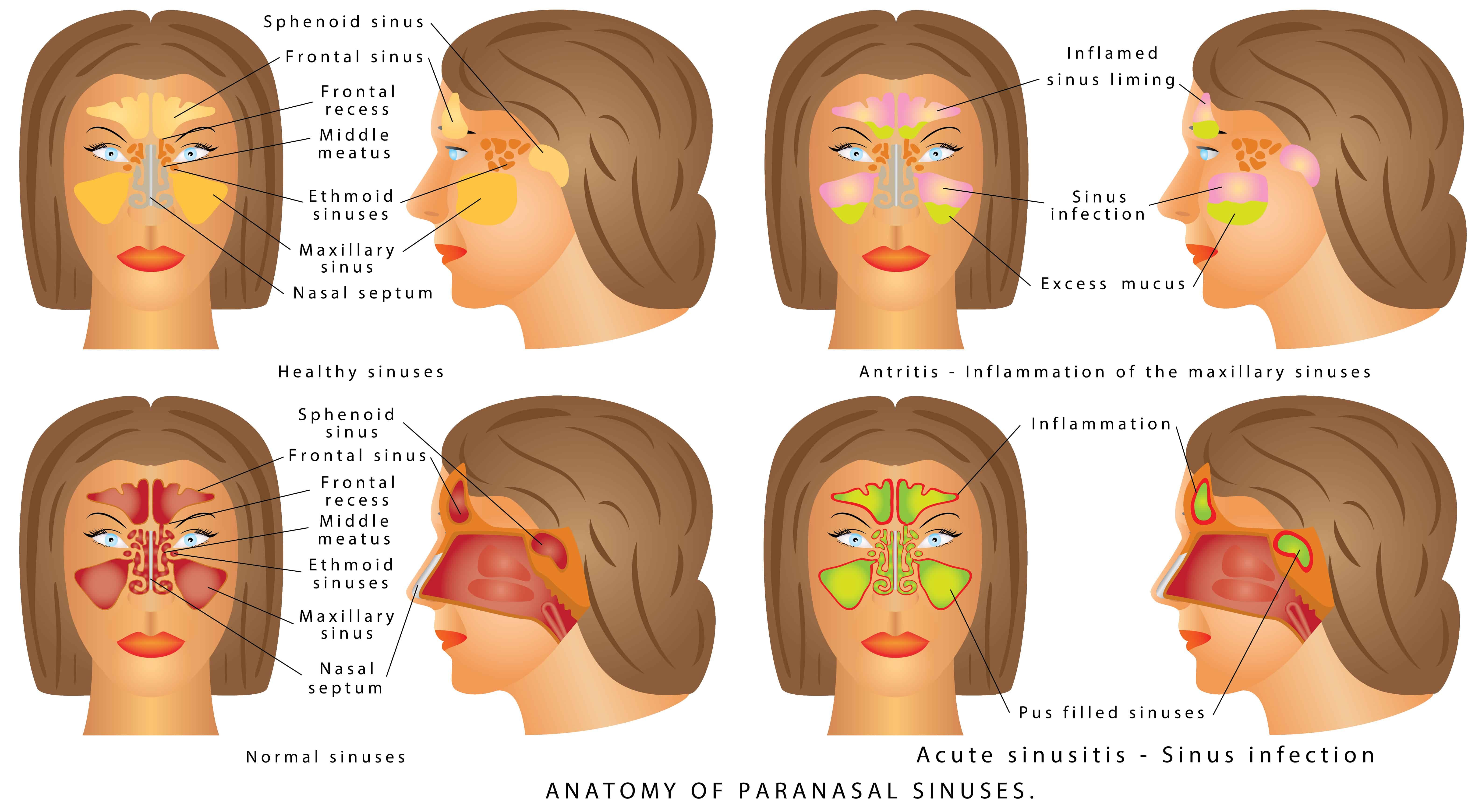
No matter what the symptom, it’s important to get plenty of rest. (9)
Complications of Sinus Infections
Viral sinus infections typically resolve in 7 to 10 days.
One possible complication of this infection is a secondary bacterial sinus infection. Signs of a bacterial sinus infection include “double worsening” (symptoms that improve and then get worse again) and sinus infection symptoms that linger for more than 10 days. (1)
Decreased sense of smell is another common symptom of a sinus infection, but this symptom may also be a complication. Chronic inflammation of the olfactory nerve can damage the nerve, affecting the sense of smell in the long term.
Sinus blockage can also lead to sinus mucoceles, or small cystic masses. These masses can become infected.
In very rare cases, sinus infections can spread to other structures.
The eye tissues can become infected, resulting in orbital cellulitis, or pus could build up behind the eye sockets (subperiosteal or orbital abscess).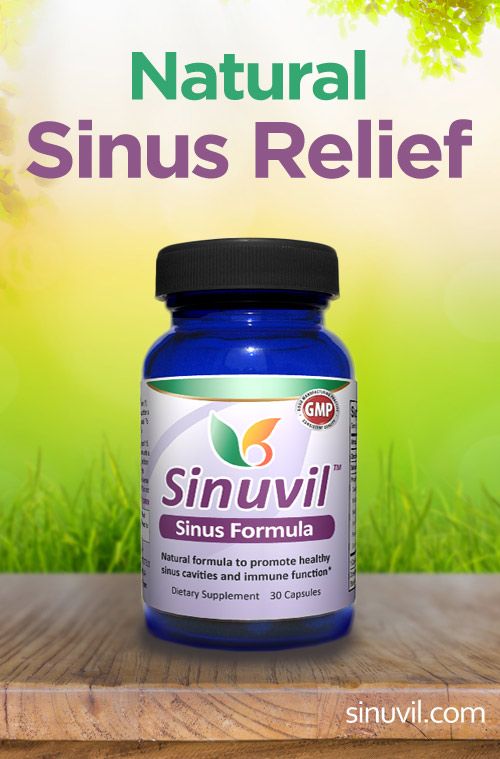
In some cases, sinus infection can lead to an infection and clotting of nearby blood vessels, a condition called cavernous sinus thrombosis.
If the infection spreads through the skull, it can affect the brain, causing meningitis or brain abscesses. An infection of the underlying bone (osteomyelitis) also sometimes occurs.
The underlying skin may also become infected, leading to cellulitis or skin abscesses.
Some of these complications can be life-threatening and require immediate medical attention, including hospitalization, intravenous medications, or surgery. Such complications are rare, but they can be more common in those who have underlying conditions, such as diabetes or weakened immune systems. (9,12)
What Is a Sinus Infection? Symptoms, Causes, Diagnosis, Treatment, and Prevention
Sinus infections occur when mucous membranes become inflamed because of an infection. Sinus blockage may precede inflammation. Learn more about sinus …
By Joseph Bennington-Castro
Neti Pots and More: 6 Smart Nasal Irrigation Tips
Nasal irrigation can ease sinus inflammation and help prevent sinus infections, especially for people with allergies or asthma. Learn how to use a neti…
Learn how to use a neti…
By Meryl Davids Landau
Home Remedies for Child Sinus Infections
Decongestants don’t help nasal symptoms in children, says new research. Take a look at pediatrician advice for treating and soothing sinus infection symptoms…
By Meryl Davids Landau
Sinus Infection Treatment and Remedies
Sinus infections often don‘t need medical treatment. Sinus pressure and pain symptoms may be relieved with home remedies like nasal irrigation and steaming…
By Joseph Bennington-Castro
Sinus Infection Causes, Risk Factors, Symptoms, Diagnosis
A sinus infection occurs when the mucous membranes lining the sinuses become infected, usually with a virus. The symptoms are similar to a cold or allergies…
By Joseph Bennington-Castro
6 Sinus Infection Self-Treatment Mistakes to Avoid
Some home remedies and do-it-yourself treatments for colds and congestion are dangerous.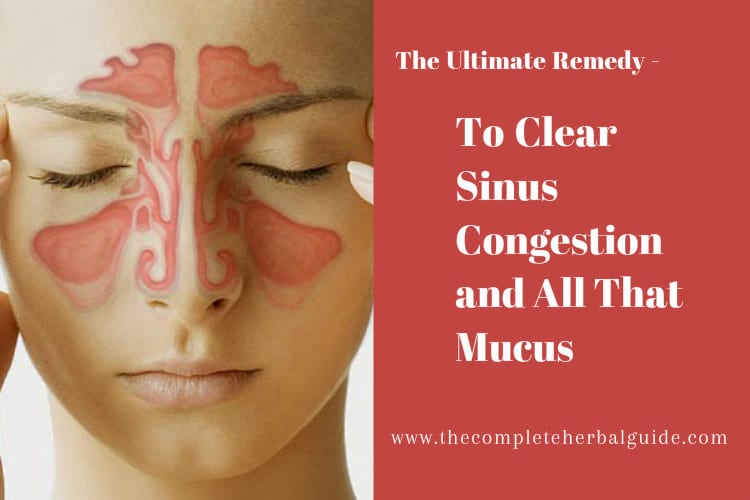 Learn about the risks for alternative remedies related to sinus…
Learn about the risks for alternative remedies related to sinus…
By Meryl Davids Landau
8 Ways to Clear Up Sinus Congestion
The best short-term and long-term ways to clear up the symptoms of a sinus infection, from people who know.
By Madeline R. Vann, MPH
Is It a Sinus Infection, a Cold, or Allergies?
Congestion can be caused by the common cold, allergies, or a sinus infection. Here’s how to tell what’s triggering your stuffy nose and other symptoms…
By Diana Rodriguez
10 Steps to Avoid Sinus Pain and Congestion
Sinus pain and congestion lead to many doctor visits. Learn why allergies and colds can cause sinus pain and how you can try to avoid sinus congestion…
By Beth W. Orenstein
How to Prevent Sinus Infections
If you’re a frequent sinusitis sufferer, then learning how to prevent sinus infections can vastly improve your quality of life.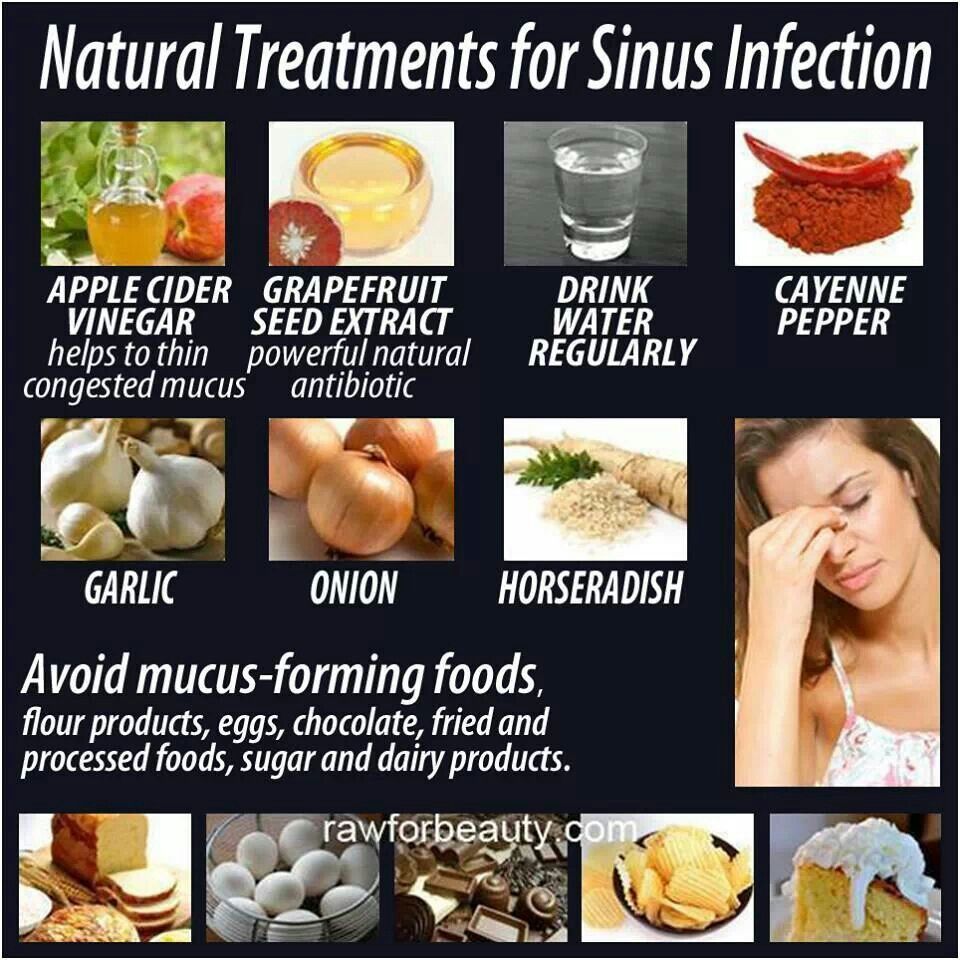
One sinus infection alone is an awful experience, but when sinus infections are recurrent and don’t respond to over-the-counter medications, they can become unbearable.
Learn about how to prevent sinus infections as much as possible and discover the treatment options available to patients who struggle with chronic sinusitis and chronic sinus drainage issues.
Common sinus infection symptoms
Before we address how to prevent sinus infections, it’s important to review what exactly a sinus is as well as common sinus infection symptoms. Sinus infections are caused by an inflammation of the nasal passages that leads to a bacterial, viral, or fungal infection.
A sinus infection may involve all or only a few of your sinus cavities and can present a wide range of systems including:
- Runny nose
- Congestion
- Tenderness of the face
- Headaches
- Fever
- Bad breath
- Feeling dizzy (learn how your sinusitis and vertigo may be related)
- Ringing in your ears (learn how your sinusitis and tinnitus may be related
Sinus infections can share many symptoms with other sinus issues, such as the common cold. If your symptoms persist for more than 10 days, you likely have a sinus infection. Since an untreated sinus infection can grow worse as well as affect other areas of the sinuses (including the ears) it’s best to visit your doctor as soon as you suspect that you may have sinusitis.
If your symptoms persist for more than 10 days, you likely have a sinus infection. Since an untreated sinus infection can grow worse as well as affect other areas of the sinuses (including the ears) it’s best to visit your doctor as soon as you suspect that you may have sinusitis.
How can I prevent a sinus infection naturally?
The good news is that some individuals are able to get rid of their recurrent sinus infections by modifying aspects of their lifestyles. To help minimize your risk of sinus infections, you can:
- Wash your hands frequently
- Keep the inside of your nose moist with nasal saline sprays (use with care and follow directions exactly)
- Keep your allergies under control with OTC or prescribed medication
- Maintain and allergen-free home
- Avoid nasal irritants such as pollution and smoke
Unfortunately, maintaining a healthy lifestyle, keeping away from allergens, and promoting healthy nasal passages may not solve the problem of how to prevent sinus infections for everyone.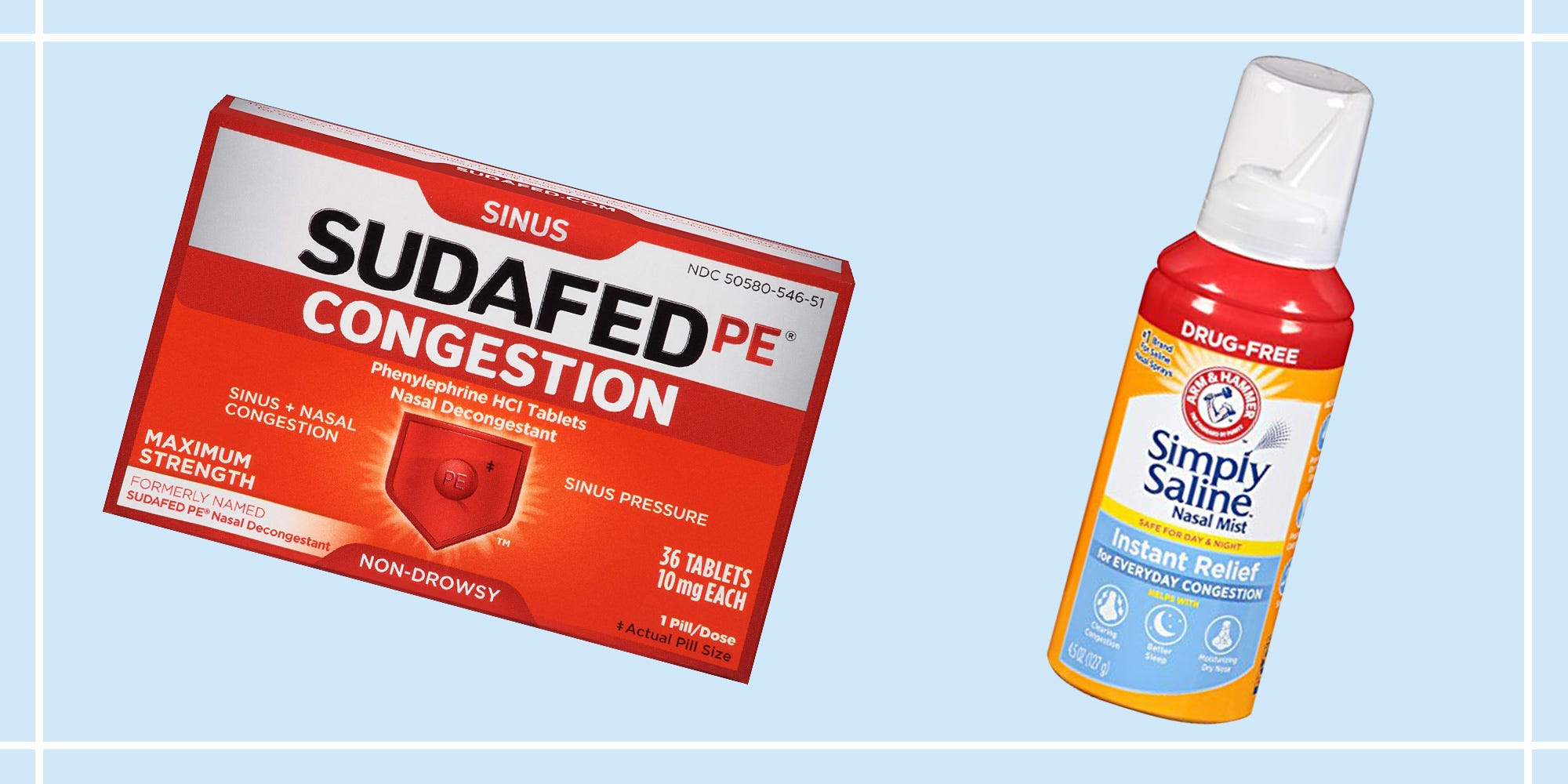 Some people are simply more susceptible to sinus infections, regardless of any preventative measures they may take.
Some people are simply more susceptible to sinus infections, regardless of any preventative measures they may take.
However, those unable to prevent sinus infections with traditional methods can come to Sinus Solutions of South Florida for the innovative balloon sinuplasty treatment.
Why do I always get sinus infections?
Sinus infections are responsible for 16 million doctor visits and $150 million spent on prescription medications. If you have continually wondered how to prevent sinus infections, you are not alone. Those who struggle most with chronic sinus infections also often have:
- Nasal polyps or a deviated septum
- Sensitivity to allergens
- Dry sinuses
- Asthma
- A weakened immune system
One or more of these conditions can dramatically increase your likelihood of having a sinus infection. Additionally, patients who experience high levels of stress are also more susceptible to sinusitis and other sinus issues.
How to treat recurrent sinus infections and a sinus infection that won’t go away
Patients whose sinus issues and frequent sinusitis do not respond well to traditional treatment often elect to undergo more drastic treatments, including sinus surgery. Traditional sinus surgeries, which involve the removal of bone and cartilage, can be extremely effective at reducing sinus issues. However, these procedures are invasive and can require extensive recovery time.
Balloon sinuplasty has neither of these downfalls and has proven to be extremely effective at restoring proper sinus drainage and relieving patients of chronic sinus infections. A minimally invasive, in-office procedure that takes less than 20 minutes and offers long-term relief, balloon sinuplasty is fast becoming the sinus infection treatment of choice for patients looking for how to prevent sinus infections on a more permanent basis.
During the procedure, an experienced ENT inserts a small endoscopic balloon into the nasal cavity. This balloon is then inflated, widening the sinus passageway and relieving the patient of congestion and other sinusitis symptoms. The best part? Balloon sinuplasty recovery takes little to no time at all. Most patients are able to return to work between one and two days after the procedure.
This balloon is then inflated, widening the sinus passageway and relieving the patient of congestion and other sinusitis symptoms. The best part? Balloon sinuplasty recovery takes little to no time at all. Most patients are able to return to work between one and two days after the procedure.
Visit the experts on how to prevent sinus infections at Sinus Solutions of South Florida
For those who struggle to gain relief through traditional methods or are impacted by multiple sinus infections a year, balloon sinuplasty can offer an alternative, life-changing solution.
If your sinus infection won’t go away, come see Dr. Bequer at Sinus Solutions of South Florida. Our highly-effective and minimally-invasive balloon sinuplasty procedure has proven successful at preventing sinus infections and helping patients get their lives back.
Dr. Bequer of Sinus Solutions of South Florida is a leading balloon sinuplasty expert in the West Palm Beach area. He and his staff can help you explore the treatment options available to you as well as whether or not you would be a good candidate for balloon sinuplasty.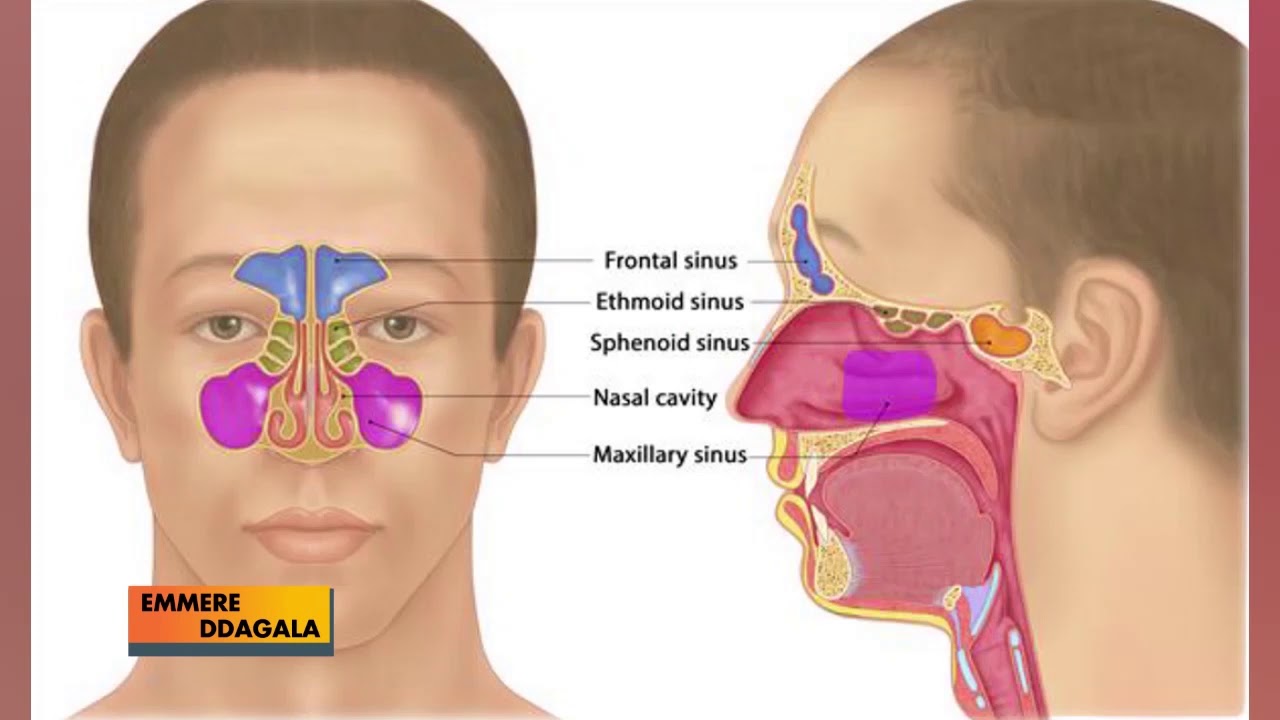
Book an appointment with Dr. Bequer by calling Sinus Solutions of South Florida at 561-790-7744 or request a consultation to see if balloon sinuplasty is right for you.
Other Helpful Articles by Sinus Solutions of South Florida:
- Balloon Sinuplasty for Deviated Septum
- How Long Does Post-Nasal Drip Last?
- Have Sinus Tooth Pain on One Side?
- Swollen Turbinates and Headaches
- Types of Hearing Loss
Prevention of sinusitis in the common cold in adults
- What is sinusitis?
- What does the prevention of sinusitis in adults include?
Runny nose, or rhinitis, is not as harmless as it is commonly thought. It not only causes discomfort and significantly worsens the quality of life, but also threatens with serious complications. One of them is sinusitis.
What is sinusitis?
Sinusitis is an inflammation of the maxillary (maxillary) sinus. The cause of the disease is most often a respiratory tract infection of a viral or bacterial nature.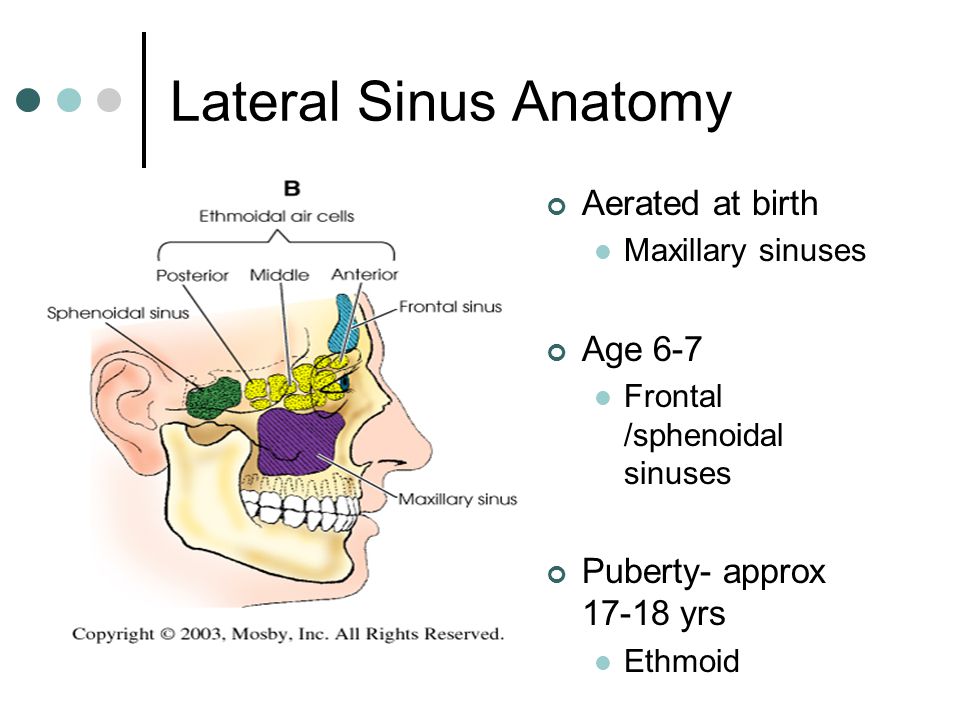 But the development of sinusitis is also possible as a result of an allergy. Sometimes sinusitis occurs as a complication of advanced diseases of the upper jaw.
But the development of sinusitis is also possible as a result of an allergy. Sometimes sinusitis occurs as a complication of advanced diseases of the upper jaw.
Sinusitis is characterized by pronounced symptoms: pain in the bridge of the nose and under the eyes, severe headache in the forehead, purulent discharge from the nose, nasal voice. Body temperature can rise to 38-39 degrees.
The disease develops over several weeks and seriously impairs the quality of life. Constant pain and stuffy nose lead to insomnia and hypoxia. In severe cases, it may be necessary to pierce the sinuses to remove pus. If sinusitis is not treated, it can turn into meningitis and even lead to swelling of the meninges.
The danger of this disease is that it often returns, and even a common cold can provoke a new episode of sinusitis. Prevention of recurrence of the disease will help prevent sinusitis with a runny nose.
What does the prevention of sinusitis in adults include?
If you often experience rhinitis or rhinosinusitis (inflammation of the nasal mucosa and paranasal sinuses), follow these rules to avoid complications:
- Avoid infections.
 During the cold season, wear a mask where there are a lot of people. In public transport or at work, use essential oils to disinfect your nasal passages. When you return home, be sure to rinse your nose to remove viruses and bacteria from the nasal mucosa.
During the cold season, wear a mask where there are a lot of people. In public transport or at work, use essential oils to disinfect your nasal passages. When you return home, be sure to rinse your nose to remove viruses and bacteria from the nasal mucosa. - If you are allergic, be sure to treat allergic rhinitis. Therapy includes antihistamines – tablets, drops or sprays, which should be prescribed by a doctor.
- Even with a runny nose, the nose should not be clogged! Clean your nose regularly to avoid spreading infection to your sinuses, use vasoconstrictor drops, or rinse your nose with sea water.
- Avoid breathing dusty or dirty air. Regularly carry out wet cleaning and ventilate the room in which you are.
- Once a year, go to the dentist and treat your teeth in a timely manner, as even the “normal” caries of the upper teeth can provoke a new episode of sinusitis.
- If you have a runny nose, carefully monitor your condition. Be sure to mark the day when the runny nose appeared.
 If a runny nose does not subside within 5 days, this is a reason to turn to Laura. You should also visit a doctor as soon as possible if the discharge becomes yellow, you constantly smell pus or rot, headaches, pressure under the eyes and in the nose area appear.
If a runny nose does not subside within 5 days, this is a reason to turn to Laura. You should also visit a doctor as soon as possible if the discharge becomes yellow, you constantly smell pus or rot, headaches, pressure under the eyes and in the nose area appear. - For the prevention of sinusitis, you can do massage in the area of the maxillary sinuses and breathing exercises. When massaging, you need to gently rub the wings of the nose, the area between the nose and upper lip, the tip of the nose, the outer corners of the eyes and the area between the eyebrows just above the bridge of the nose. Breathing exercises include simple exercises – for example, 10 breaths and exhalations through each nostril. However, massage and gymnastics have contraindications. In order not to harm yourself, you need to consult a doctor.
We should also mention the role of essential oils in the prevention of sinusitis. They act in several directions at once: they disinfect the air and respiratory tract, reducing the risk of infection of the sinuses, increase the immunity of the nasal mucosa and improve its condition, helping the body to suppress the disease, and also facilitate breathing, thereby eliminating another factor in the development of sinusitis.
What essential oils will help to avoid sinusitis? This is primarily fir oil, mint, eucalyptus and lavender oils have shown themselves well, which have antiviral, antibacterial and antiseptic effects.
The easiest and most convenient way to use essential oils for the prevention of sinusitis is with the Dyshi ® inhaler stick (more about the product can be found here). It contains all of the high quality essential oils listed above. You can use it at home, at work, in transport, on the street. You just need to remove the cap, bring the pencil to the nasal passage, take two breaths in each nostril. By the way, the Dyshi® inhaler can be used in the complex therapy of the common cold along with vasoconstrictor drops and sea water for washing.
IS NOT ADVERTISING. THE MATERIAL IS PREPARED WITH THE PARTICIPATION OF EXPERTS.
Chronic sinusitis: symptoms, treatment and prevention
Contents
- 1 Chronic sinusitis: symptoms, causes and treatment
- 1.
 1 Chronic sinusitis: a complete guide
1 Chronic sinusitis: a complete guide - 1.2 Chronic sinusitis: understanding the disease
- 1.3 Symptoms of chronic sinusitis
- 1.4 Let’s analyze causes of chronic sinusitis
- 1.5 Diagnosis of chronic sinusitis
- 1.5.1 Clinical signs
- 1.5.2 Instrumental diagnosis
- 1.5.3 Methods of laboratory diagnosis
- 1.6 Treatment of chronic sinusitis: basic methods
- 1.7 Drug treatment of chronic sinusitis
- 1.8 Physiotherapy methods of treatment of chronic sinusitis
- 1.9 Cyrilization in chronic sinusitis
- 1.10 Surgical treatment of chronic sinusitis
- 1.11 Prevention of chronic sinusitis
- 1.12 Conclusions
- 1.13 Related videos:
- 1.14 Q&A:
- 1.14.0. 1 What are the symptoms of chronic sinusitis?
- 1.14.0.2 How is chronic sinusitis diagnosed?
- 1.14.0.3 How is chronic sinusitis treated?
- 1.14.0.4 What folk medicines can help with chronic sinusitis?
- 1.
 14.0.5 How can chronic sinusitis be prevented?
14.0.5 How can chronic sinusitis be prevented? - 1.14.0.6 Can chronic sinusitis lead to complications?
- 1.
Chronic sinusitis is a disease characterized by chronic inflammation of the mucous membrane of the maxillary sinus. Symptoms, causes, methods of diagnosis and treatment – you will learn all about this from our article.
Chronic sinusitis is a condition in which the mucous membrane of the maxillary sinus is almost constantly inflamed, sometimes due to a bacterial infection. This is a common disease that can significantly impair the quality of life of patients.
Symptoms of chronic sinusitis may include chronic nasal congestion, swelling, nasal discharge, headache, deterioration or loss of smell, fatigue, coughing, and constant oversatiation. Chronic sinusitis can be caused by a variety of factors, including infection, allergies, nasal polyps, sinus damage, and other medical problems.
An important aspect of the prevention of chronic sinusitis is the maintenance of strong immunity, regular nasal hygiene and timely treatment of respiratory and other medical problems. Daily strengthening of the protective function of the body can significantly reduce the risk of disease in patients with a predisposition to it.
Daily strengthening of the protective function of the body can significantly reduce the risk of disease in patients with a predisposition to it.
Chronic sinusitis: a complete guide
Chronic sinusitis is a chronic inflammation of the mucous membrane of the maxillary sinuses, which is manifested by various symptoms, such as a runny nose, soreness and pressure in the cheeks and eyes, headache and an unpleasant smell from the nose.
Treatment of chronic sinusitis may include antibiotics, nasal irrigation with saline or hypertonic solutions, topical glucocorticosteroids, and, if necessary, surgery.
Prevention of chronic sinusitis includes measures to strengthen the immune system, exposure to factors that contribute to the development of the disease (eg, smoking), proper care of the nasal cavity and regular examination by an ENT doctor to detect the disease at an early stage.
- Symptoms of chronic sinusitis: runny nose, soreness and pressure in the cheeks and eyes, headache, bad breath, nasal congestion, etc.

- Treatment of chronic sinusitis: antibiotics, nasal irrigation, local glucocorticosteroids, surgery.
- Prevention of chronic sinusitis: strengthening of immunity, influence on the factors contributing to the development of the disease, proper care of the nasal cavity, regular examination by an ENT doctor.
SymptomsTreatmentPrevention
| Runny nose | Antibiotics | Immunity boost |
| Cheek pain and pressure and eye | Nasal irrigation, topical glucocorticosteroids | Treatment of factors contributing to the development of the disease |
| Headache | Surgery | Proper care of the nasal cavity, regular examination by an ENT doctor 90 147 |
| Bad breath | ||
| Nasal congestion |
Chronic sinusitis: understanding the disease
Chronic sinusitis is a chronic inflammation of the maxillary sinuses, which is one of the most common diseases affecting the upper respiratory tract.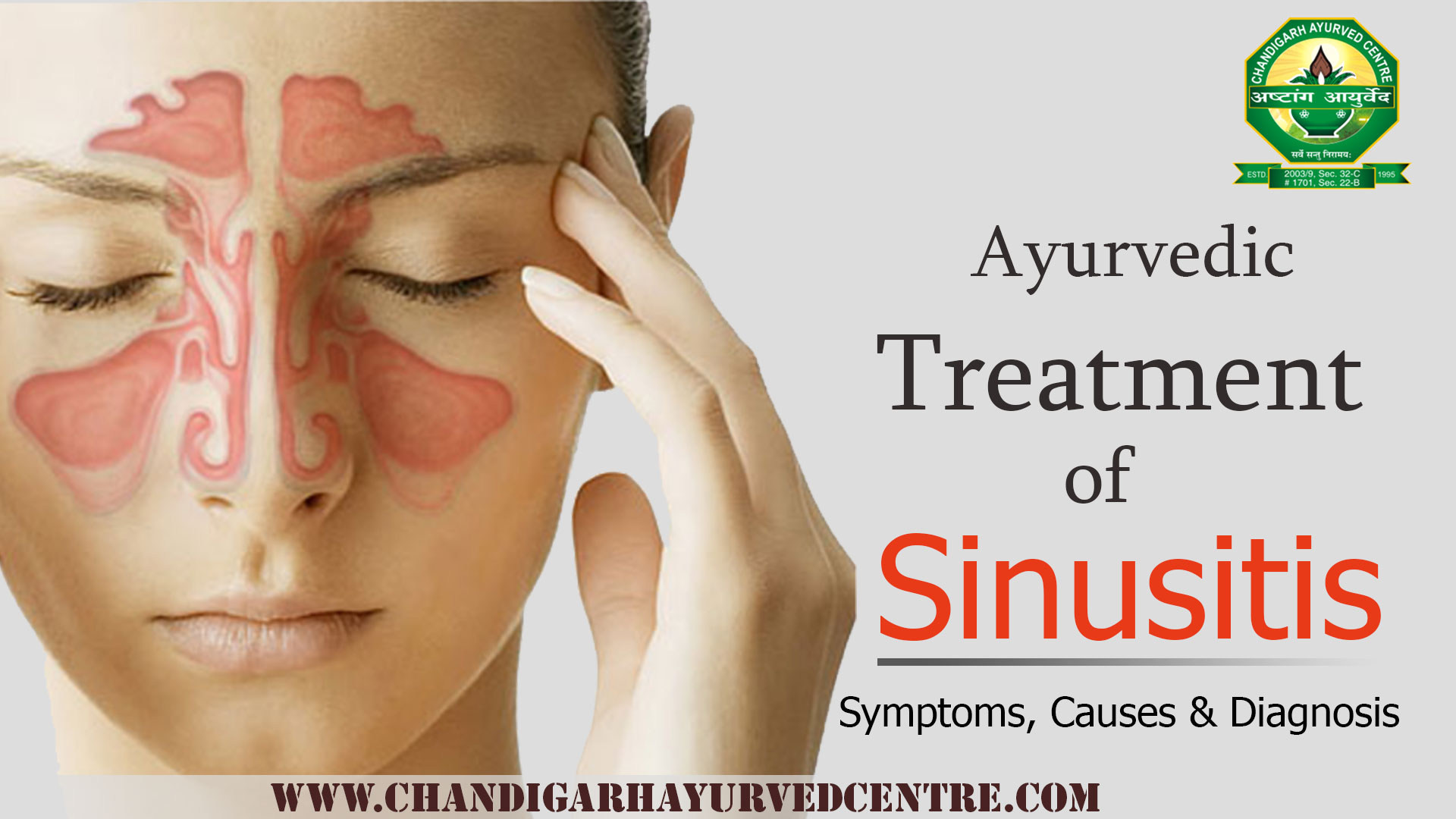
To effectively treat chronic sinusitis, it is important to carefully evaluate the symptoms and prescribe adequate treatment. Treatment of chronic sinusitis can be complex and depends on many factors such as the degree of inflammation, chronicity, duration of illness, medical history, age of the patient, and other medical concerns.
- The main approaches to the treatment of chronic sinusitis include
- antibiotic therapy
- the use of antiviral and anti-inflammatory drugs,
- the use of cryotherapy
- the use of homeopathy
- immunotherapy
- surgical treatment
In general, the treatment of chronic sinusitis can take from several months up to several years, so it is important to monitor your health, follow prevention and regularly consult with a specialist.
Symptoms of chronic sinusitis
Chronic sinusitis is an inflammatory disease of the mucous membrane of the maxillary sinuses.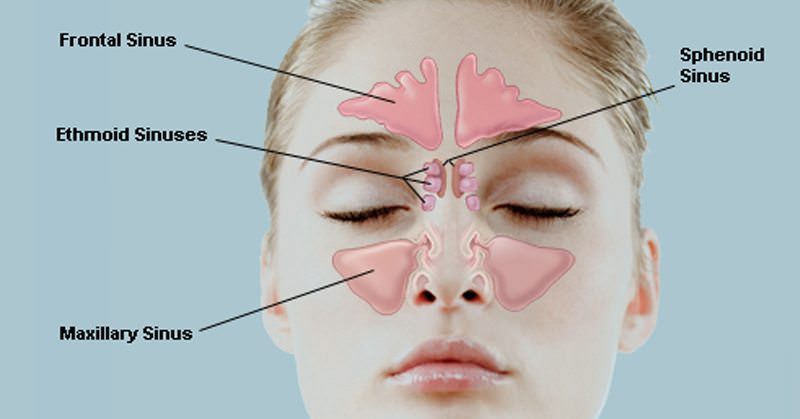 In the initial stage of the disease, the symptoms may be subtle and not cause concern. However, as the disease progresses, the symptoms become more severe and can lead to serious health problems.
In the initial stage of the disease, the symptoms may be subtle and not cause concern. However, as the disease progresses, the symptoms become more severe and can lead to serious health problems.
The main symptoms of chronic sinusitis are:
- Runny nose, nasal congestion, difficulty breathing;
- Constant feeling of heaviness in head and brow ridges;
- Headache worse when bending head;
- Nasal discharge which may be purulent, cloudy or yellowish;
- Sensation of fullness in the ear or simultaneous appearance of sinusitis with active summer coryza;
- Temperature increase;
- Smell disorder.
If you notice at least a few of the listed symptoms, you should consult an otorhinolaryngologist. Only an experienced specialist can make an accurate diagnosis and prescribe adequate treatment.
Let’s analyze the causes of chronic sinusitis
Chronic sinusitis can occur for various reasons, often it is associated with a long stay of a person in a polluted, dusty or highly crowded atmosphere.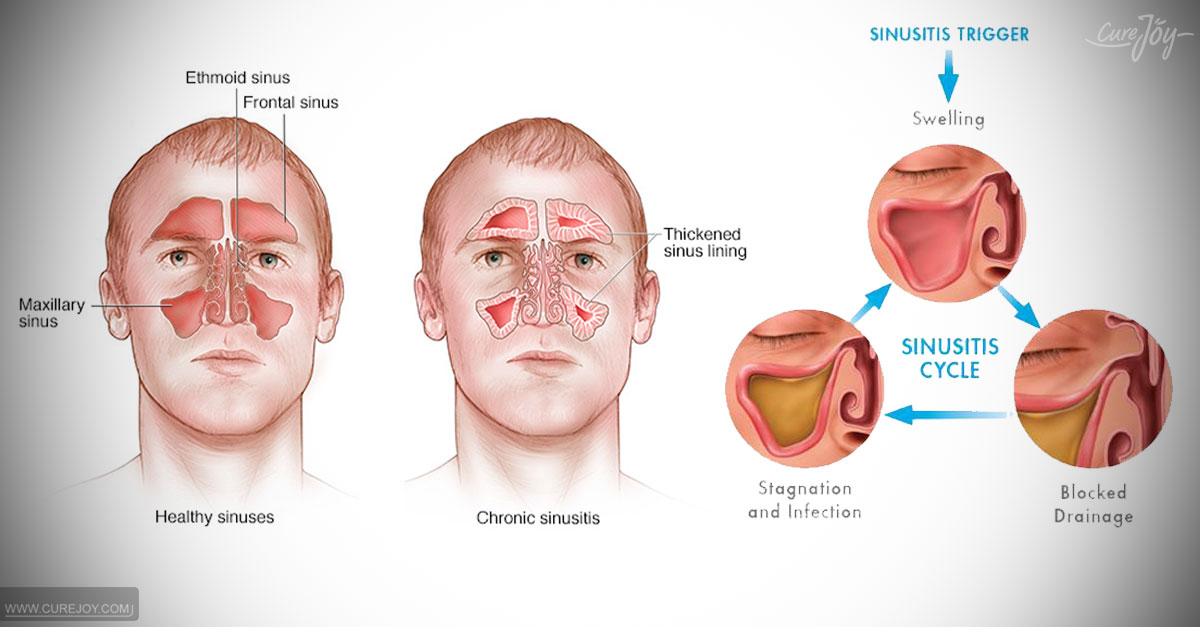 An allergic reaction to various external and internal factors can also contribute to the onset of the disease. It can also be caused by a disease of the human immune system, also known as an autoimmune disease.
An allergic reaction to various external and internal factors can also contribute to the onset of the disease. It can also be caused by a disease of the human immune system, also known as an autoimmune disease.
However, some people may be predisposed to chronic sinusitis due to anatomical features of their nasopharynx, such as fractures, polyps, or deformities of the nasal septum. In addition, sinusitis can develop due to complications of previously transmitted respiratory infections, such as influenza or SARS, not fully cured at an early stage.
- air pollution and dustiness
- allergic reactions
- immune system disorders
- anatomical features of the nasopharynx
- complications of respiratory infections
Diagnosis of chronic respiratory infections morita
Clinical signs
Chronic sinusitis can present with a variety of symptoms, but common signs are:
- Constant or intermittent flow of pus or mucus from the nose.

- Recurring soreness in the forehead, brow ridges, cheekbones and nose.
- No sense of smell.
- General weakness and fatigue.
- Change of voice (possibly rare).
- Fever (in some cases).
Instrumental diagnostics
For accurate diagnosis of chronic sinusitis, the following methods can be used:
- Radioscopy of the nasal cavities.
- Computed tomography.
- Magnetic resonance imaging (MRI).
- Rhinoscopy.
- Endoscopy.
These methods allow you to determine the degree of sinus damage, identify advanced cases of chronic sinusitis and give recommendations for treatment.
Methods of laboratory diagnostics
Methods of laboratory diagnostics of chronic sinusitis allow to establish the presence of an inflammatory process and determine the type of pathogen, which helps to determine the treatment regimen and prescribe antibiotic therapy, if necessary.
Research method Advantages Disadvantages
| Blood test | Reliable and accurate method | Not informative enough in chronic sinusitis |
| Examination of nasal mucus | Allows you to identify the type of pathogen | The method does not always give a positive result |
| Fluorescence microscopy | Allows to see microorganisms in mucus | It is not always possible to obtain material for research |
Treatment of chronic sinusitis: basic methods
Chronic sinusitis is a complex infectious pathology that requires complex and long-term treatment.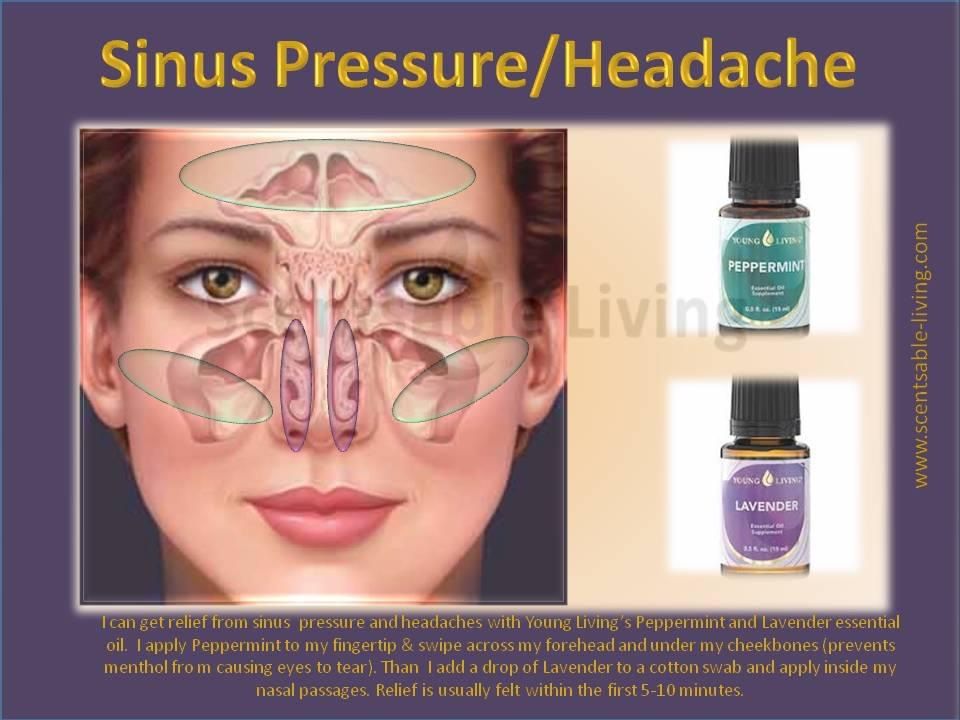 Basically, the treatment is aimed at reducing the inflammatory process and eliminating its causes.
Basically, the treatment is aimed at reducing the inflammatory process and eliminating its causes.
To improve the outflow of purulent masses from the maxillary sinus, methods of washing with saline solutions and physiotherapy are used. These methods reduce the swelling of the mucous membrane and accelerate the regeneration of damaged tissues.
If conservative treatment fails, surgery may be required. Depending on the stage of the disease, a complete therapeutic sanitation of the maxillary sinuses, removal of polyps, damaged tissues and bone obstructions can be carried out.
Drug treatment of chronic sinusitis
Treatment of chronic sinusitis is complex and should include medication and surgery. Drug treatment is aimed at eliminating the inflammatory process, reducing mucosal edema and eliminating bacterial infection.
The main treatment is antibiotics, which can be presented in the form of tablets, drops or ointments. Often, doctors prescribe drugs in combination with mucolytic and antihistamine drugs.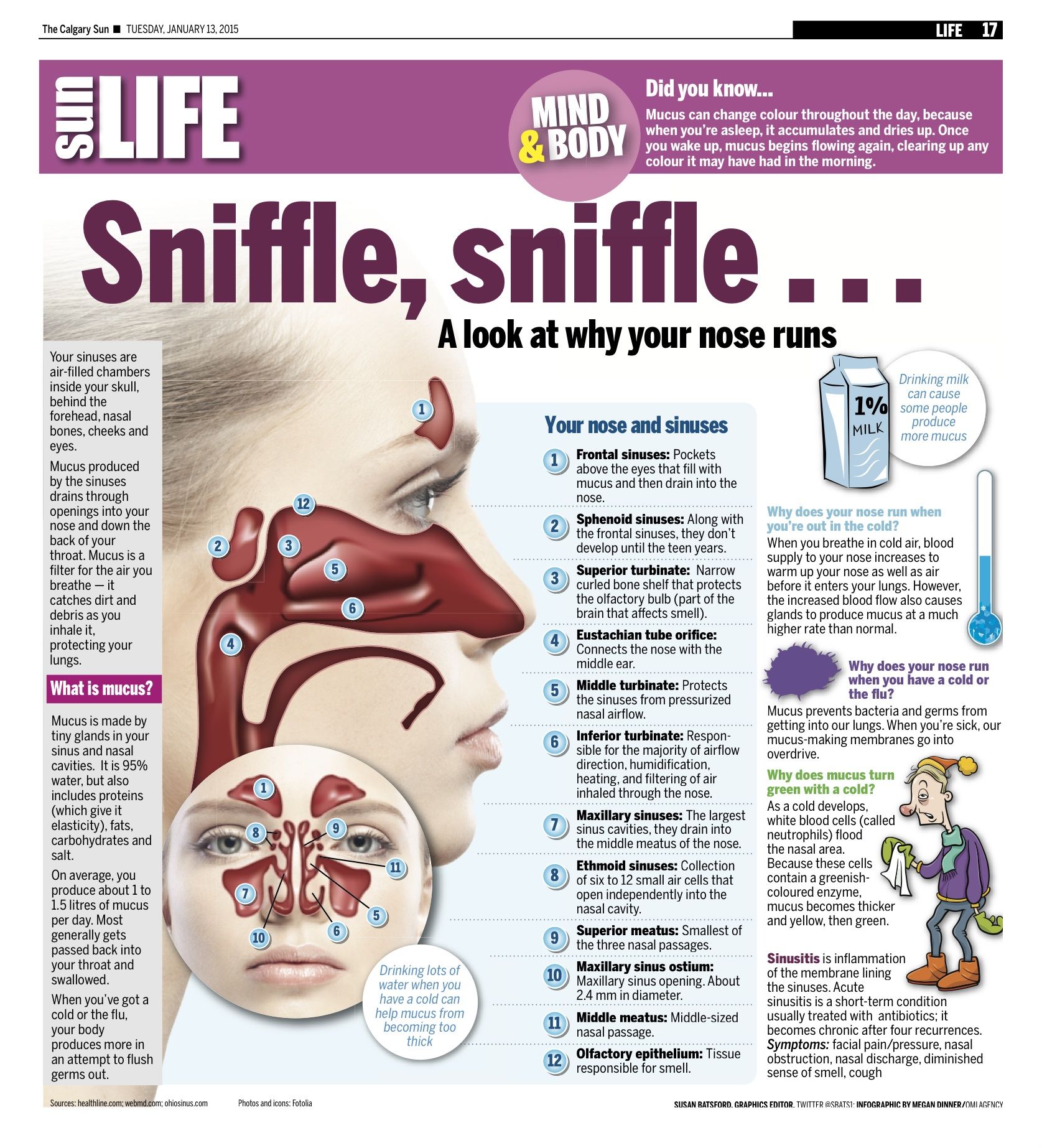 This allows you to more effectively deal with the symptoms of the disease and speed up the healing process.
This allows you to more effectively deal with the symptoms of the disease and speed up the healing process.
In some cases, the use of glucocorticosteroids may be required. They are able to relieve swelling that occurs as a result of the inflammatory process, as well as reduce the degree of mucus secretion and improve the penetration of drugs into tissues.
However, it is worth remembering that self-treatment can be dangerous, and only a doctor should treat sinusitis. The wrong dosage or the wrong drug can only aggravate the situation and provoke the development of complications.
Physiotherapy for chronic sinusitis
Physiotherapy is an effective treatment for chronic sinusitis, especially when combined with medical therapy. These methods are aimed at eliminating the inflammatory process, improving blood circulation and stimulating the immune system.
Ultrasound therapy – The use of ultrasound to improve blood circulation and reduce swelling in the sinuses. Ultrasound therapy also increases the permeability of cell membranes and activates metabolism, which contributes to the rapid restoration of healthy tissues.
Ultrasound therapy also increases the permeability of cell membranes and activates metabolism, which contributes to the rapid restoration of healthy tissues.
Mineral water inhalations – this method of treatment of chronic sinusitis is aimed at reducing inflammation and eliminating cough. Inhalations are carried out using special devices and droppers, to which mineral waters are added, containing trace elements and minerals that have a positive effect on the mucous membranes of the nose and maxillary sinuses.
Laser therapy is an exceptionally painless treatment that aims to eliminate the inflammatory process. Laser therapy accelerates blood circulation and metabolism, improves oxygen supply and ensures rapid recovery of damaged tissues.
These and other physiotherapeutic procedures are selected individually, depending on the degree of development and nature of the disease. Do not forget that the considered methods of treatment should be used only after consulting a doctor.
Kirillization in chronic sinusitis
In chronic sinusitis, chirillization is one of the effective methods of treatment. Cyrilization is that the nasal passages and paranasal sinuses of the nasal cavity are washed with a solution of potassium and calcium. This method helps to remove pus and mucus, which can cause discomfort and lead to the progression of sinusitis.
Kirillization is a safe and quick procedure that is performed in the clinic or at the patient’s home. Depending on the severity of the disease, kirillization can be performed daily or every few days.
Note: after cyrilization, yellow discharge may be observed, which is considered normal. If after the procedure the patient has redness, swelling or soreness, you should immediately contact your doctor for advice.
In addition to cyrilization, it is very important to take care of the prevention of chronic sinusitis. To do this, it is recommended to eat right, strengthen the immune system, regularly carry out wet cleaning in the room, do not abuse salty and sweet foods, smoking, and also observe personal hygiene of the nasal cavity.
Surgery for chronic sinusitis
Chronic sinusitis is a common condition that can be caused by a variety of factors, such as bacterial or fungal infection, allergies, or deformity of the nasal septum. Many patients with chronic sinusitis can manage with medication, but sometimes surgery becomes necessary.
One of the common methods of surgical treatment of chronic sinusitis is endoscopic surgery. This method allows the operation to be performed without incisions, so that patients recover faster. During endoscopic surgery, a doctor uses an endoscope—a thin tube with a camera and instruments at the end—to remove trapped mucus and other materials from the sinuses. This reduces inflammation and prevents recurrences.
Another method of surgical treatment of chronic sinusitis is a three-wall operation. During this operation, the doctor removes the bones that separate the maxillary sinuses to improve their drainage. This allows for better blood flow and reduced inflammation. To prevent recurrences, doctors may use implants to help keep the sinuses open.
To prevent recurrences, doctors may use implants to help keep the sinuses open.
Prevention of chronic sinusitis
Chronic sinusitis can be prevented by following certain measures and preventive actions. The following recommendations may help prevent chronic sinusitis:
- Drink more fluids. Drinking enough fluids, at least 1.5-2 liters a day, will help clear your sinuses, which will reduce the possibility of infection and sinusitis.
- Regular intake of vitamins such as vitamin A and C and zinc can boost immunity and help fight infections.
- Compliance with the rules of nasal hygiene. Regular nasal washing with saline solutions and inhalations can help clear the lining of the nose and sinuses.
- Avoid contact with harmful substances. Avoid working or living in environments where the air is saturated with toxic or irritating substances such as smoke, dust, and others.

- Preventive dental procedures. Timely dental treatment and regular visits to the dentist can prevent the development of infections that can develop into sinusitis.
By following the recommendations for prevention, you can reduce the risk of developing chronic sinusitis and reduce its impact on quality of life.
Conclusions
Chronic sinusitis is a common disease among the population. It can lead to prolonged headaches, nasal congestion, and other unpleasant symptoms. This disease can be diagnosed using various methods, from a routine examination by an ENT doctor to x-rays and magnetic resonance imaging.
Treatment for chronic sinusitis includes antibiotics, nasal irrigation with saline solutions, surgery, and other methods. Depending on the severity and duration of the disease, the doctor may prescribe a combination of these methods.
However, the best way to deal with chronic sinusitis is to prevent it. Regular rinsing of the nose with saline solutions, strengthening the immune system, maintaining a healthy lifestyle, avoiding contact with allergens, and other measures will help prevent the development of the disease.
Comparative analysis of sinusitis treatment methods Method of treatment Advantages Disadvantages
| Washing the nose with saline solutions | + no side effects + availability and ease of use | – not always effective in severe cases of sinusitis |
| Use of antibiotics | + rapid elimination of the inflammatory process | – possibility of side effects – risk of microorganism resistance to the drug |
| + radical elimination of the disease | — high cost — the possibility of various complications after surgery |
Thus, chronic sinusitis is a serious disease that must be treated under medical supervision. However, it is even better if you take measures to prevent it, as this will help to avoid the appearance of the disease in the future.
Related videos:
youtube.com/embed/AHjeJZZdOPc” frameborder=”0″ allowfullscreen=”allowfullscreen”>
Q&A:
What are the symptoms of chronic sinusitis?
Among the most common symptoms are: smell and taste disorders, headaches, fatigue, weakness, general malaise, fever, frequent colds, runny nose, unfair fatigue, nasal congestion, lack of desire to eat due to loss of appetite.
How is chronic sinusitis diagnosed?
Computed tomography, x-rays, endoscopy, blood tests, and nasal swab tests are usually ordered to diagnose sinusitis. A comprehensive study will determine the degree and form of sinusitis and prescribe the optimal treatment.
How is chronic sinusitis treated?
Treatment of chronic sinusitis depends on the degree and form of the disease. Anti-inflammatory and antibiotic drugs, traditional medicines and physiotherapy are usually prescribed. In more severe cases, surgery may be required to remove problem areas of the mucosa.
What folk medicines can help with chronic sinusitis?
To improve the condition with sinusitis, you can use decoctions and infusions from herbs and plants, such as tansy, chamomile, calendula, oregano.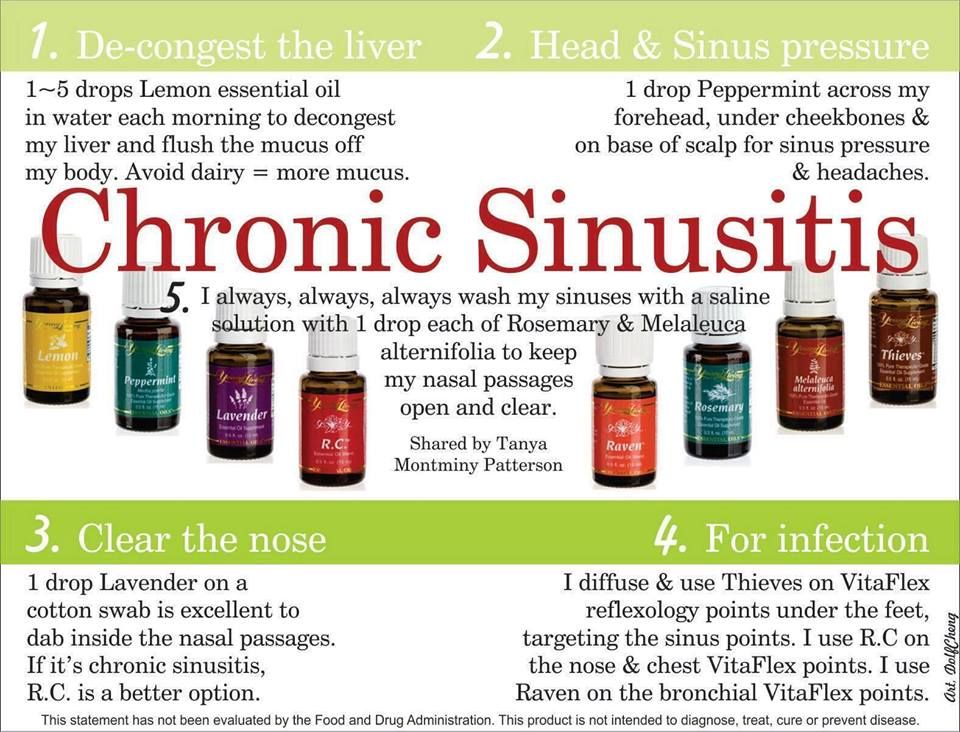

 During the cold season, wear a mask where there are a lot of people. In public transport or at work, use essential oils to disinfect your nasal passages. When you return home, be sure to rinse your nose to remove viruses and bacteria from the nasal mucosa.
During the cold season, wear a mask where there are a lot of people. In public transport or at work, use essential oils to disinfect your nasal passages. When you return home, be sure to rinse your nose to remove viruses and bacteria from the nasal mucosa. If a runny nose does not subside within 5 days, this is a reason to turn to Laura. You should also visit a doctor as soon as possible if the discharge becomes yellow, you constantly smell pus or rot, headaches, pressure under the eyes and in the nose area appear.
If a runny nose does not subside within 5 days, this is a reason to turn to Laura. You should also visit a doctor as soon as possible if the discharge becomes yellow, you constantly smell pus or rot, headaches, pressure under the eyes and in the nose area appear. 1 Chronic sinusitis: a complete guide
1 Chronic sinusitis: a complete guide 14.0.5 How can chronic sinusitis be prevented?
14.0.5 How can chronic sinusitis be prevented?

